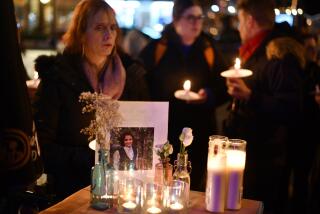Charm School for Bullies : Education: Elementary schools are seeing such an increase in aggressive behavior that they have to find ways to address it.
- Share via
Chances are he wouldn’t remember you after all these years, but there’s no way you’ll ever forget him.
You know the one: The kid who made your stomach knot when you spotted him on the playground.
The one who tried to muscle you for lunch money each day, and then hissed, out of earshot of the teacher, that you were dead meat once the final bell rang.
The childhood bully is more than a lingering memory. He remains a presence at elementary schools nationwide. “There always have been one or two of these kids at every school, but now we’re seeing such an increase in this type of bullying behavior that elementary schools are beginning to realize that they have to address it,” said John Hall, coordinator of the elementary counseling program for the Los Angeles Unified School District. “Teachers who have been in the system for 25 or 30 years say they can’t stand what is happening with these young kids now, and that something has to be done.”
Something is being done. To ease the bully problem, the district has started a “charm school” of sorts, a program that administrators call Conflict Resolution.
Last month, letters were sent to the district’s 71 elementary schools, inviting them to participate in the new program. The 10-week course will try to teach students and teachers how to deal with name-calling, teasing, fighting over places in line, disagreement over rules of a game.
Children wearing sashes that identify them as “Conflict Busters” will be taught how to approach other students when they see trouble brewing on the playground, and then how to help their peers resolve the differences before adult intervention becomes necessary. Many of the children in the program will know the problems posed by bullies firsthand, since they have been identified by teachers as being overly hostile or aggressive.
At Coldwater Canyon Elementary School in North Hollywood, Principal Jilanne Fager said that since a pilot program was implemented two years ago, fighting and arguing during lunch periods and at recess has decreased. “The kids who were aggressive are a lot better at controlling thems1701607013playground talking about their disagreements now instead of automatically responding to things physically.”
One 9-year-old who has been a Conflict Buster since September said that until he took the conflict resolution training, his quick temper often got the better of him. Now, things have changed.
“I always used to fight. Someone would get in front of me in line or call me a name, and that would be it,” said Jesus Hernandez, a fourth-grader at Coldwater Canyon. “Now if someone calls me a name I know fighting doesn’t settle it. Now I say to them, ‘It’s not nice to call someone names. Next time you do that I’m not going to play with you.’ They usually stop it.”
Richard Mills, a school district psychologist who began the pilot program at Coldwater Canyon School and will conduct training sessions at other schools, said he believes the program has the potential to reach many more children in a similar way. “The problem for a lot of these kids is that they don’t know any other way to handle anger and frustration, or to get what they want. They don’t know why they are cruel and mean and punch little kids, and so they’re just stuck on this treadmill.
“What we’re hoping is that if these aggressive kids can learn new negotiating skills and channel their need for power positively, it will help some of them get off that treadmill,” he said.
In recent years, the introduction of conflict-management techniques for aggressive children has created a growing number of “charm schools” for bullies across the country. Based on the theory that bullies are made and not born--and that bullies can be unmade--the programs attempt to reach hostile children early. In so doing, the goal is to nip potential juvenile delinquents in the bud.
“There’s a lot of new research going on that has prompted many schools to develop programs to help these children deal with other people,” said Patricia Edmister, director of children’s studies and developmental psychology at the California Family Study Center in North Hollywood. “Basically, the schools are beginning to look at it as a learning disability that the children have when it comes to social skills.”
Although the programs vary in their size and approach, many are conducted at elementary schools with the help of local universities.
In one such program, Duke University psychologist John Lochman holds weekly sessions with aggressive fifth- and sixth-grade boys in 12 different Durham, N.C., public schools. Although girls also exhibit aggressive behavior, Lochman said, the “bullying syndrome” is most often seen in young boys.
Lochman begins each session by asking one boy to construct a model tower out of dominoes, while other kids in the room make noise, tease him and call him names. Later, he said, the boys discuss what did and didn’t work in terms of screening out the distractions.
“The ones who do the best told themselves to forget about everything else and not to think about it, which is an important concept to learn if you’re trying to teach kids some self-control,” Lochman said.
Role-playing sessions, in which one boy assumes the role of bully and another becomes the victim, are designed to give children some alternatives to their “fist-first” approach to confrontations. Before the hostility in the role-playing reaches a peak, Lochman said, the confrontation is abruptly stopped and both boys are then asked what they were thinking and feeling as the conflict heated up. The idea, he said, is to “get them to think of other ways that they can deal with conflict and to recognize a problem when it first starts.”
In another program, Harvard University psychologist Robert Selman brought aggressive children together in a Cambridge, Mass., elementary school, where they learned and put into practice socially acceptable ways of coming to terms with each other. After providing the boys with pieces of a model that they were unable to construct on their own, the children were then shown that they could accomplish their goals if they learned to work together.
Other schools report using different techniques to try to reach aggressive children, including art therapy and the use of puppets. In some cases, children may be referred by teachers or principals to school mental health centers for in-depth counseling.
Although the long-term effects of school-based programs are not yet fully known, educators seem convinced of one thing: Aggressive kids who aren’t reached early are unlikely to make an emotional turnaround on their own later on.
Several studies tend to support that belief. Lochman said that one study conducted by University of Illinois psychologist Leonard Eron followed 600 children from age 8 to 30, and found that children who bullied in elementary school were five times more likely to have been convicted of a crime by age 30 than their less aggressive counterparts. They also had a higher incidence of drug abuse, delinquency in school and incidence of child abuse with their own children.
“What we found is that early levels of aggression are fairly accurate at predicting later levels of aggression,” Lochman said. “It’s becoming increasingly clear that, without help, these kids will have a much higher risk of a negative outcome.”
What causes a child to become easily angered, get into fights at the drop of a hat, intimidate other children and, in short, become a first-class bully? Right now, mental-health professionals disagree on whether the primary cause is learned behavior or genetic--a rehash, some say, of the “nature vs. nurture” question. But they tend to agree that certain factors can be key contributors.
Most experts concur that the way parents deal with aggression is often transmitted to their children.
“A lot of these kids have parents who have disciplined them to the point where it is counterproductive. They try to get a child to eat, or to go to bed or to conform in some way, and because of its intensity that behavior by the parents is actually bullying,” said Dr. Carlo DeAntonio, a Sherman Oaks child psychiatrist and also an associate clinical professor of psychiatry at the USC School of Medicine. “Kids often learn that kind of behavior firsthand,” he said.
Other children who become overly aggressive, however, may have parents who behave in just the opposite way. “These are kids who have somehow been taught that the sun rises and sets with them, that they can do no wrong and that whatever they want they should have,” DeAntonio said. “These kinds of bullies are ones who are overwhelmed with having no limitations.”
And then there may be times when a child becomes hostile to other children because of depression, stress or frustration at having a learning disability. Psychologists say it is not uncommon for a child to act out emotional turmoil--such as over a divorce or poor grades--in a physical way.
One factor, however, does seem to apply to the majority of bullies. Several studies have found that aggressive children are much more likely to assume a hostile intent by others, even when no hostility was intended.
“In an ambiguous social situation, the aggressive kids tend to zero in on any aspect that could be construed as hostile or threatening to them,” Lochman said. “They may see someone walking down the hall with a frown and accidentally bump into him, and automatically they assume that it couldn’t have been an accident.”
Lochman and other psychologists say it is no simple task getting a child to change his perception that the world is a place where he must fight to get what he wants. Nor is it likely, they add, that elementary school programs can single-handedly accomplish that goal.
But many experts believe that the programs are a beginning.
“Until now, a lot of the bullies have been referred to our clinic by principals or teachers, and we work with them and their parents here. But it’s really time that the problem is addressed at the school sites where it is going on,” said Alison McAlpine, a psychiatric social worker and also the coordinator of the Kindergarten Intervention Program with the district’s School Mental Health Services.
“I think a lot of people are going to be glad this is finally happening,” McAlpine said, pausing for a moment. “Especially, a lot of those pushed-around little kids.”
More to Read
Sign up for Essential California
The most important California stories and recommendations in your inbox every morning.
You may occasionally receive promotional content from the Los Angeles Times.













